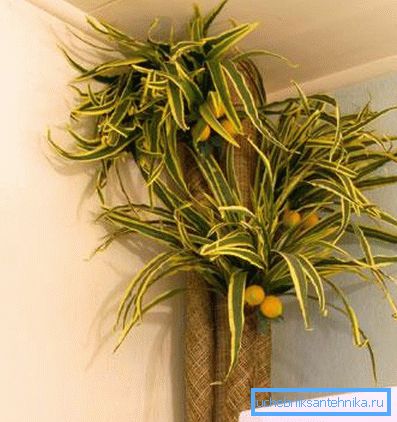How to hide the heating pipes: laying in the wall and floor,
Most of the residential and office premises of our country have water heating. This option is time tested and deservedly enjoys popularity. But along with decent technical characteristics, the aesthetic side leaves much to be desired. The question of how to hide the heating pipes in a private house, apartment or office is asked by many owners.
You can act in different ways, there is always the option to call specialists and do everything thoroughly, but the price of such services bites. Although a person who knows how to handle a traditional household tool, such as a hammer, screwdriver, grinder or hammer drill, will be able to do everything with his own hands. And finally, it is possible not to strain at all, buy ready-made screens or decorate pipes with improvised means.
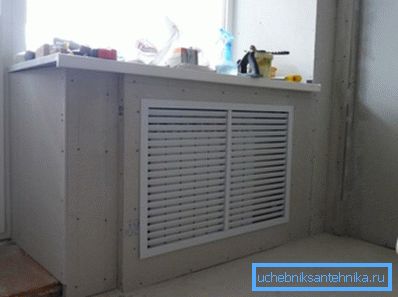
Preparatory activities
Whichever method you choose, you should start with a major audit of the heating system. It is foolish to mount the decoration on the old leaky pipes. Moreover, if you try to hide such wiring behind a massive stationary screen, then there is a chance that due to a leakage, soon everything will need to be broken and re-mounted.

Any specialist will tell you that it is not recommended to wall a metal pipe. As for the plastic systems, you should pay attention to the connecting fittings for pipes. Access to compression joints should always be open, because the likelihood of a leak is high. You can hide only crimp or solder construction.
In addition, you need to carefully inspect the pipes themselves. If there is the slightest doubt in reliability, do not risk it, it is better to immediately change part of the pipeline. And then, the less different types of links on the track, the higher the reliability of such a track.
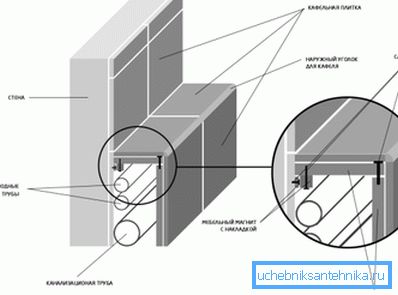
Tip: a centralized heating system in high-rise buildings does not always produce the desired temperature. If you hide the connecting structures, the heat transfer area will be significantly reduced. In this case, the wiring is better not to hide or change the radiators for more voluminous ones.
Hidden layout in walls or floors
This option is considered the most time-consuming, but at the same time, immured pipes will definitely not interfere with anyone. And what is especially important for small premises, valuable living space will not be taken.
Important: it is better to wall up exclusively plastic constructions. Do not take risks with the metal, it will rust and with the amount of chemistry that is now being added to the centralized heating system, the pipes will quickly become unusable.
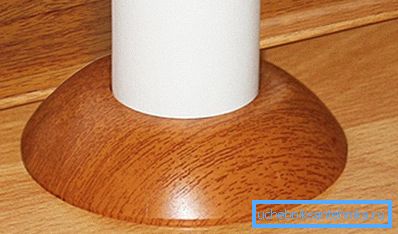
Bookmark the wall
- Before you hide the plastic heating pipes in the wall, you need to carefully prepare. The first thing to start with is to sketch out as detailed and accurate a sketch of the route as possible, including the diameter of the pipeline, as well as all the connections and turns. Then all this is transferred directly to the wall.
- Further work instructions are theoretically simple and straightforward, but in practice the work is quite laborious and dusty.. At this stage, making the strobe under the wiring. You are very lucky, if you have a wall chaser, this is a tool similar to a grinder, but equipped with 2 discs. In extreme cases, you can do with one grinder with a diamond disc.

- When the track is cut to the desired depth, the inside of the gate must be knocked out.. This can be done with a perforator or chisel and hammer. Take into account that the thermal expansion of plastic reaches 5 mm. Still need to leave space for insulation around the pipe. Plus, the plaster layer covering the structure should be around 20 mm.
- The pipe in the gate is fixed using plastic or metal brackets, which in turn are attached with dowels.
- Before closing the layout with a plaster layer, the system needs to be well driven both under operating conditions and under elevated pressure., in order to identify all the weaknesses.
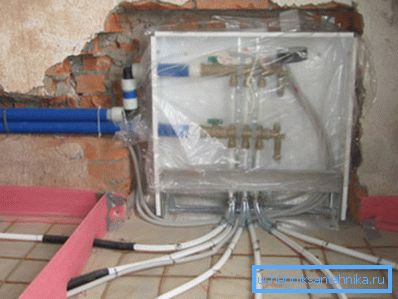
Tip: when picking up plaster for walling up pipe wiring, you should not use gypsum-based compounds. When the temperature rises, the putty will dry out and crack. Experts advise to use only cement mortars.
How to hide in the floor
The ability to cut through the strobe in the floor is rare. The vast majority of overlap is made on the basis of reinforced concrete slabs. Cutting these structures is extremely dangerous, especially in high-rise buildings.
Therefore, there are 2 outputs. First, hide the wiring in a thick concrete screed or the second option, hold between the laminated or laminated wood flooring.

As for the concrete screed, according to the requirements it must be poured above the wiring at least 20 mm. As a result, the weight of such a cake will be significant and not every overlap can withstand it.
The option of masking pipes between the carrier lags of floor structures is almost perfect. But before you hide the heating pipes in the space under the flooring take care that there are no rodents. Otherwise, your heating will be eaten quickly.
Various boxes and screens
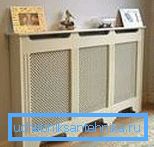
Hinged or side boxes and screens are considered to be the fastest and most economical way of decoration. To build a small structure of drywall, even without a lot of experience can be a couple of days. A specialist with such work will cope in a couple of hours. Serial hinged boxes or screens hang a maximum of half an hour.
The biggest disadvantage in this version is that part of the living space is eaten. If the lines are long, you can lose up to several square meters.
The box can be made in the form of a solid false wall or as a small ledge, exclusively for decorating a package of pipes. But in any case, small decorated gaps are left in the upper part of the box, they are needed for ventilation. Plus, thus, the heat from the wiring will flow into the room.

As for the mounted screens, they are more relevant for decorating the radiators directly, pipes, as a rule, are closed with boxes.
Tip: it is not necessary to decorate the box, diverting attention from it. An interesting solution could be the placement of illuminated glass stained glass on the front of the box. Especially beautiful will look like vertical columns of this kind.
The video in this article shows some options for the pipe layout.
Conclusion
Since hiding the heating pipes in the apartment of a multi-storey building is completely, more difficult and more expensive, experts advise to pay attention to the installation of boxes. Although if the apartment with high ceilings, it is an excellent option of installation in the floor between the lags. If the situation is hopeless, you can decorate the pipe itself.
